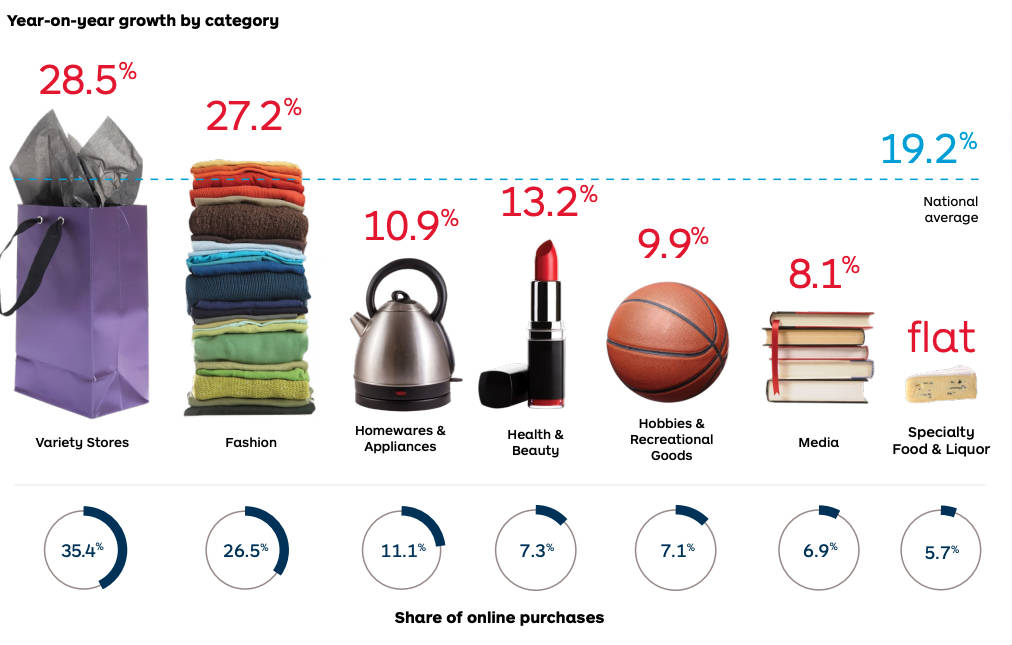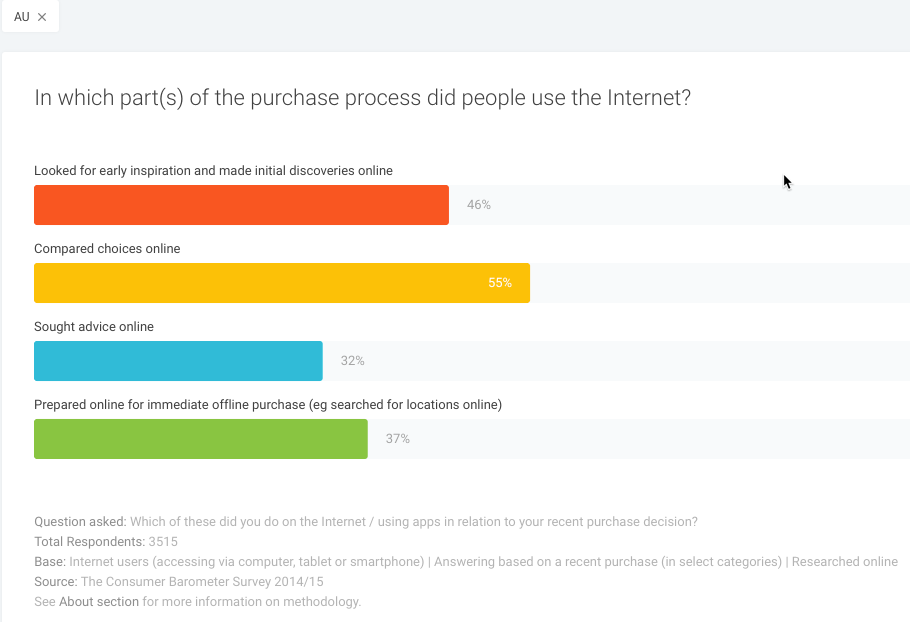The impact of COVID-19 on the results of companies in 2020 is undeniable. The ecommerce sector, however, seems to have strengthened with the crisis. With millions of people stopping shopping at malls and now placing orders online, companies like Amazon and eBay have grown stronger in the past year. Likewise, thousands of small and medium-sized businesses have had to adapt to online sales. Shopify, despite being a CMS specific for ecommerce, has become the second most present CMS on the web, behind only of the ubiquitous WordPress.
Below, you can see some of the 2020 and 2021 statistics updated with sources for you to use in your presentation – at college or at work.
Online shopping is growing, and many retailers have now adapted to the evolving preferences of consumers. They have now adopted a multi-channel approach.
Competition from international retailers like Amazon has grown and it is becoming critically important to stay ahead of trends and embrace digital technology.
Retail is no longer about “bricks and mortar,” it’s about “clicks and mortar.” Below are some trends explaining why.
This is Part 4 in a Series of Articles on e-Commerce.
- Part 1: Tactics to Boost e-Commerce Sales
- Part 2: How to Supercharge Your Online Store
- Part 3: How to Measure The Effectiveness of Your Online Campaigns
Here are some of the ecommerce trends that we believe will happen in 2021:
- Reduced number of online stores: some disorganized companies shall abandon their digital sales channel. They will return to ecommerce only if there is a new lockdown.
- Greater competitiveness among companies that remain online: companies are investing millions in ads on Google and Facebook, in addition to optimising their sites with SEO. Companies that continue to offer an online sales channel must face an organised competition and need to go beyond the basics to remain sustainable in 2021.
- Videos influencing more and more online sales: Video is the fastest growing type of content in the world today. Ecommerce companies that do not offer product presentation in video format will be behind the competition.
- Websites can display more complex content. With the adoption of 5G, high resolution videos and images will no longer be an obstacle to digital consumption …
- … as long as they respect the Google’s Core Web Vitals: These are a set of metrics related to speed, responsiveness and visual stability of a website and are fundamental for SEO nowadays.
Data from Shopify
Shopify recently launched a report called “The future of ecommerce in 2021“. Here are the main takeways from this report:

As countries locked down and retailers were forced to close, ecommerce reached an all time high of 16.4% of total global retail sales. According to a global survey across markets by Shopify, 84% of consumers shopped online during the pandemic.
Asia-Pacific leads the regional totals for both retail and retail ecommerce sales. APAC will be responsible for 42.3% of retail sales worldwide.
Trends Impacting e-Commerce Stores
- Online shopping is growing at a faster rate than traditional retail.
- Major brands have now become multi-channel.
- Mobile commerce continues to grow.
- Changes in consumer behaviour and expectations.
- Marketplaces, websites that allow 3rd parties to sell their product direct to consumers, will continue to grow.
Online Shopping Growth & Spend
- Australians spent $21.3 billion buying goods online in 2017 and had 18.7% growth according to Australia Post’s “Inside Australian Online Shopping” report.
- Online shopping in Australia reached 9% of total traditional retail sales in FY2018
- It is predicted that by 2020, 1 in 10 items will be brought online.
- Retail spending via the internet grew 9% year on year in the year ending December 2018 (NAB Retail Sales Index, 2018)
What Are They Buying?
According to Australia Post, the top 3 products brought online by spend are:
- Consumer electronics
- Clothing (with Activewear the leading purchase according to Australia Post, “Inside Australian Online Shopping, Feb 2019”)
- Books
Where are they buying?
Consumers still prefer to shop at traditional retailers with the most visited Australian websites comprising of well known retailers, like Bunnings, Woolworths, Jbhi, Coles and Kmart, according to Inside Retail.

Including international sites, the most popular websites visited Australians were, eBay, Amazon, Bunnings, and Amazon.

What categories are growing?

The role of the Internet on Australian Purchase Behaviour
- 58% of Australians consult the web to research their purchases (Google Consumer Barometer, 2014/2015)
- 45% use search engines to make a purchase decision (Google Consumer Barometer, 2014/2015)

The rise of marketplaces
- Marketplaces grew by 74.8% in 2017, Australia Post, Inside Australian Online Shopping.
- Stores like Catch and Myer have opened marketplaces which have allowed them to expand into other categories, defend against Amazon and compete with other marketplaces eBay, Kogan, Etsy & Redbubble.
Mobile Commerce
- 72% of Australian consumers use mobile devices for payments, PayPal mCommerce Index Australia 2017
- Only 51% of online businesses are optimized to accept mobile payments, PayPal mCommerce Index Australia 2017
- The number of Australian smartphone users who buy via mobile at least once a week has increased 12% (36% in 2016 vs. 48% in 2017), PayPal mCommerce Index Australia 2017
- A quarter of those surveyed now prefer smartphones over all other devices for making online purchases – a jump of almost 40% YoY (18% in 2016 vs 25% in 2017), PayPal mCommerce Index Australia 2017
Social Commerce
- 4 in 5 Australian businesses don’t sell via social platforms, PayPal mCommerce Index Australia 2017
- 30% plan to do so.
How has online shopping changed?
- More purchases from mobile devices – in 2017, one in five online purchases were made from a mobile device.
- Payment services such as Afterpay attracted over 1.5 million customers.
- Shoppers demand a frictionless end-to-end shopping experience.
- They expect flexible delivery timeframes & collection points.
- Sales events, like click frenzy, black Friday, boxing day, shape retail sales more than ever
What Australian shoppers want – implications for online stores
- Making your website mobile responsive is not an option – it’s a must.
- Offer a variety of payment options.
- Offer a frictionless shopping experience and let consumers pick up where they left off after abandoning a purchase.
- Provide flexibility and options for delivery.
- It’s the details that count – offer a personalized experience by setting your store to remember who the customers are.
- Consumer access information via multiple channels (e.g. eBay, search, email). Widen your distribution by adopting an integrated multi-channel strategy
- Become data savvy and understand your goals.
- Start segmenting your customer base to overcome the threat of competition.
- Consider offering free delivery & build delivery into the product price – your customers want it.
Sources
- Australia Post, Inside Australian Online Shopping, Feb 2019
- Australia Post, Inside Australian Online Shopping, 2018 eCommerce Industry Paper
- PayPal mCommerce Index Australia 2017
- Paypal mCommerce Annual Report, September 2018
- NAB Online Retail Sales Index, December 2018
- Neto, State of eCommerce Report 2018
- Google, Consumer Barometer
- Inside Retail: https://www.insideretail.com.au/news/ebay-still-dominates-online-shopping-in-australia-201905
Source: PayPal mCommerce Index Australia 2017
